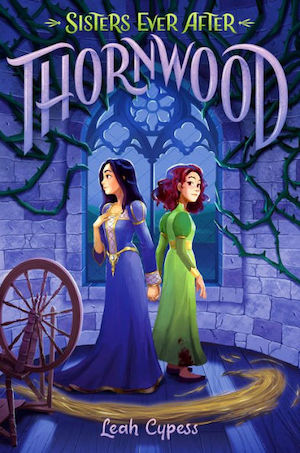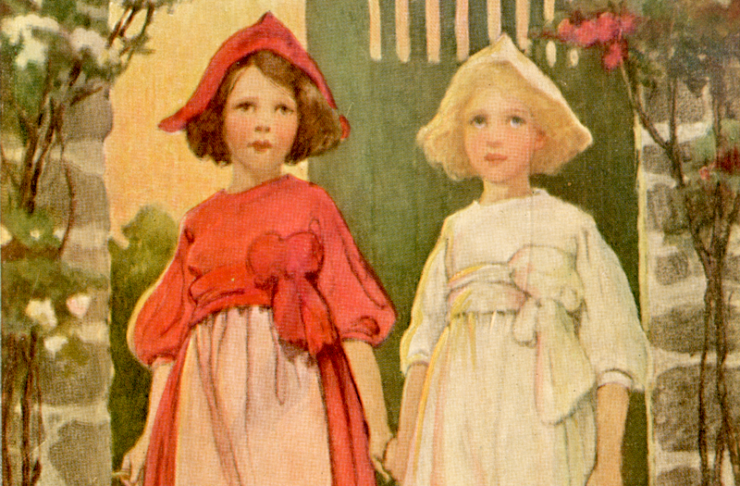Frozen was widely heralded for its focus on a sister relationship instead of a romantic one—the first Disney fairy tale retelling that was about a bond between sisters. But the movie was (extremely loosely) based on The Snow Queen—a fairy tale that doesn’t even have a sister in it.
My upcoming middle grade book, Thornwood, is told from the point of view of Sleeping Beauty’s little sister, and is going to kick off a series of retellings, called Sisters Ever After, about “the sisters the fairy tales left out.” I had a lot of fun weaving the complexities of a sister relationship into a story that was originally about an only child. But at some point I started to wonder: why does a fairy tale about sisters seem like such a novel concept? After all, most fairy tales didn’t originate at a time when only children were the norm. Yet a search through popular fairy tales reveals a smattering of sister-brother combinations, and a couple of jealous, conniving sisters, but not many sisters who work together.
So I set out to find fairy tales and fairy-tale retellings that have good sister relationships at their core.
Fairy Tales About Loving Sisters
Snow White & Rose Red is the quintessential fairy tale that is, in its essence, about sisters who love and help each other. And it does, in fact, have a number of retellings that keep this sisterly relationship intact: Snow White and Rose Red by Patricia C. Wrede, Snow & Rose by Emily Winfield Martin, and most recently, Blanca & Roja by Anna-Marie McLemore, which combines this story with that of the Seven Swans but keeps its focus on the relationship between its two Latina sisters.
The Goblin Market by Christina Rossetti is another great example of a story in which sisters save each other. In fact, it ends with the main characters, years later, telling their children the story and leaving no room for doubt about its moral:
Then joining hands to little hands
Would bid them cling together,
“For there is no friend like a sister
In calm or stormy weather…”
The Goblin Market shows up as scenery or side-plot in a number of fantasy novel—The Demon’s Lexicon by Sarah Rees Brennan springs to mind—and was recently made the center of a popular, critically-acclaimed retelling: Sisters of the Winter Wood by Rena Rossner, which moves the story to an Eastern European Jewish shtetl.
Twelve Dancing Princesses has sisters in abundance: not just a pair, but twelve of them. My friend Diana Peterfreund described it as “every fairy-tale-loving writer’s favorite fairy tale” (note: guilty as charged), so it’s no surprise that this has been retold numerous times in many different ways. Most of the retellings are faithful to the core of the story while surrounding it with a rich world and complex relationships—i.e. Jessica Day George’s Princess of the Midnight Ball, Juliet Marillier’s Wildwood Dancing, and Heather Dixon’s Entwined. But the story also lends itself to a variety of twists, as exhibited in the horror-tinged House of Salt & Sorrows by Erin A. Craig or the Roaring-Twenties version in The Girls at the Kingfisher Club by Genevieve Valentine.
In many versions of Bluebeard, the wife’s sisters come to save her (or rather, bring their husbands to save her). There is also an Italian version of this story, called How the Devil Married Three Sisters, in which the sisters probably had a great relationship before the first two were murdered. But the modern retellings of this fairy tale mostly leave the sisters out—these days, after all, we want our heroines to save themselves.
There are also other, lesser-known fairy tales that feature helpful sisters. The Red King from Northern India, was brought to my attention by a blog post lamenting the lack of sisters in European fairy tales. Molly Whupple is a Hansel & Gretel variant in which there are three sisters instead of a brother and a sister. And then there’s Kate Crackernuts, a Scottish tale that involves a girl’s head being turned into a sheep’s head. The only practical result of this transformation seems to be embarrassment for the girl in question. Luckily her stepsister saves her, while also curing a prince along the way and scoring them both royal husbands.
Bad Sisters Flipped Into Good Ones
Some of the more well-known fairy tales feature sisters who don’t—to put it mildly—get along. These fairy tales tend to delve into the pitted-against-each-other, seething-with-jealousy, trying-to-(literally)-kill-each-other variety of sibling rivalry.
But even these stories can be retold in a way that make them about deeper, better relationships between siblings.
Cinderella’s wicked stepsisters are, of course, the quintessential bad sisters. But when this tale is flipped and the stepsisters are the main characters, the relationship between the two of them might be one you want to root for. Prime examples: Stepsister by Jennifer Donnelly and Confessions of an Ugly Stepsister by Gregory Maguire. Interestingly, both these books end up bringing all three sisters together in a complex but ultimately supportive relationship. (In the second book in the Sisters Ever After series, I’m going to give Cinderella a third stepsister, to give those relationships a new twist.)
In Beauty and the Beast—or at least in some versions of it—Beauty’s sisters conspire to keep her from returning to the Beast, almost leading to his death. In the Disney version, the sisters are written out of the story altogether. But in several retellings, the sisters are transformed into close friends who ultimately support Beauty and each other. Two of the most gorgeous of these retellings were written by the same person—Robin McKinley, author of Beauty and Rose Daughter.
Sisters Added
Frozen and Thornwood are not the only retellings to add sisters to a fairy tale that never had one in the original. Two other examples are Sisters Red by Jackson Pearce (which basically splits Little Red Riding Hood into two girls), and The Woodcutter Sisters books by Alethea Kontis, which mashes up a number of fairy tales and assigns each sister an adventure of her own.
***
You’ll notice one fairy tale that doesn’t appear on this list: Sleeping Beauty, which is the story I chose to retell in Thornwood. That story struck me as particularly ripe for this sort of retelling, because of its singular focus on Sleeping Beauty alone… despite the fact that the entire castle was put to sleep when she was. How did those people feel about being caught in the curse? What was Sleeping Beauty’s relationship to them? By giving Sleeping Beauty a little sister, I was able to both keep my retelling tied to the power of the original, but also expand it so that it’s not only about Sleeping Beauty and her prince. Turns out, when you add a sister to a story, you add a whole new dimension to it.
Fairy tale retellings have been popular for a long time, which means there must be many other examples I’ve missed. I’m hoping to hear about more fairy tale sisters in the comments! And if anyone has any theories about why there aren’t more of them, I’d love to hear those too.
Buy the Book


Thornwood
Leah Cypess is the author of four YA novels: Mistwood, Nightspell, Death Sworn, and Death Marked. Both Mistwood and Death Sworn were on the Kirkus Best Books for Teens list, and Death Sworn was a Teen Vogue “Most Exciting YA Book” of the year. She lives in Silver Spring, Maryland. Thornwoood is her middle grade debut. Visit her online at her website or follow her on Twitter @LeahCypess.










